Photos by Hajime Miyatake: Injured Victims |
|
| In the Ruins
|
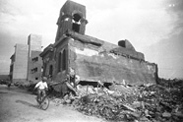 |
| 27 |
Shimomura Jewelers
Approx. 620m from the hypocenter, Harimaya-cho (now, Hondori)
|
|
The two-story ferroconcrete Shimomura Jewelers topped by a clock tower was the handsomest building on Hondori. Its first story was completely smashed. The second story and clock tower tilt west to east.
|
|
|
Hiroshima Gas Head Office
Approx. 210m from the hypocenter, Ote-machi 3-chome (now, Ote-machi 2-chome)
|
|
The shot looks south from a street in Ote-machi. As if to demonstrate the direction of the hypocenter, the northeast corner was crushed from the third story down to the first.
|
| 28 |
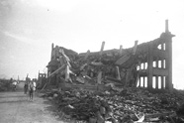 |
|
|
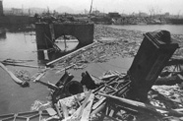 |
| 29 |
The fallen Honkawa Bridge
Approx. 450m from the hypocenter, Tsukamoto-cho (now, Sakai-machi 1-chome)
|
|
The Honkawa Bridge was rebuilt in 1897 as a permanent bridge with steel trusses, the most advanced bridge structure of its day. The new bridge immediately became a popular attraction. The atomic blast tore up the steel trusses and collapsed the bridge, leaving only the stone columns.
|
|
|
Destroyed Imperial Headquarters
Approx. 910m from the hypocenter, Moto-machi
|
|
The Chugoku Regional Military Headquarters was located on the grounds of Hiroshima Castle. The bomb leveled and burned the entire castle and wrecked most of the military facilities. The photo shows the wreckage of the former Imperial Headquarters established during the Sino-Japanese War in 1894.
|
| 30 |
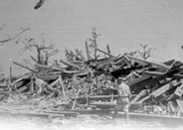 |
|
|
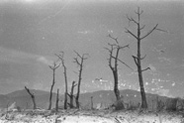 |
| 31 |
Trees burned down to the trunk
Approx. 860m from the hypocenter, Moto-machi
|
|
The hawks circling overhead suggest that corpses are lying in the open.
|
|
|
Pine tree broken by the blast
Approx. 630m from the hypocenter, Moto-machi
|
|
The photo looks south from the center of the Western Drill Ground. The ridges visible behind the tree are vegetable gardens dug into the drill ground to help compensate for food shortages.
|
| 32 |
 |
|
|
 |
| 33 |
People entering the city for rescue and relief
Approx. 1,180m from the hypocenter, Yamaguchi-cho (now, Kanayama-cho)
|
This panoramic shot extends from the burnt plain of the city to the west side of Hiroshima Higashi Police Station. People are heading toward the city center along the burnt-out streetcar street to join rescue efforts or search for loved ones. Immediately after the bombing, thousands of soldiers, rescue teams, civil defense teams, and others entered the city to rescue the injured, collect corpses, and restore city functions. All were exposed to residual radiation.
Click on any photo for detailed information. |
|
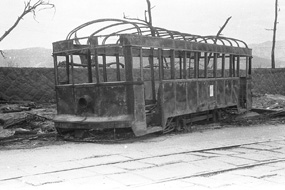 |
| 34 |
Streetcar completely gutted by fire (Model 150)
Approx. 320m from the hypocenter, Moto-machi
|
|
The streetcar packed with passengers was headed towards Hiroshima Station about 70 meters east of the Kamiya-cho intersection when the atomic bomb consumed it in fire. The stonewall visible behind the streetcar surrounded the Hiroshima Castle moat that then extended as far as the Aioi Bridge and Hatchobori.
|
|
 |
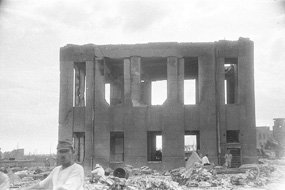 |
| 35 |
Japanese Red Cross Society, Hiroshima Chapter
Approx. 210m from the hypocenter, Sarugaku-cho (now, Ote-machi 1-chome)
|
|
Only the shell of the ferroconcrete building remained; 15 employees perished. The fresh-looking cords of wood piled up on the right in front of the building were probably brought in for cremating the dead.
|
|
|
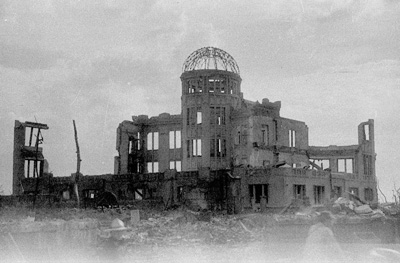 |
| 36 |
Hiroshima Prefectural Industrial Promotion Hall
Approx. 160m from the hypocenter, Sarugaku-cho (now, Ote-machi 1-chome)
|
|
The unmistakable rounded top so near the hypocenter earned it the name "A-bomb Dome" and turned it into a symbol of the horror of atomic bombing. Many photographed it, but this shot is thought to be the earliest photo with an unobstructed view of the ruins.
|
|
|










